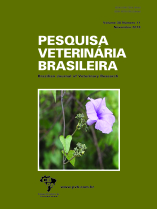 |
|
|
|
Year 2018 - Volume 38, Number 11
|

|
Epidemiological and clinical aspects of ophidian bothropic accidents in dogs, 38(11):2146-2149
|
ABSTRACT.- Silva L.G., Panziera W., Lessa C.A.S. & Driemeier D. 2018. Epidemiological and clinical aspects of ophidian bothropic accidents in dogs. [Aspectos epidemiológicos e clínicos dos acidentes ofídicos botrópicos em cães.] Pesquisa Veterinária Brasileira 38(11):2146-2149. Setor de Patologia Veterinária, Faculdade de Veterinária, Universidade Federal do Rio Grande do Sul, Av. Bento Gonçalves 9090, prédio 42505, Porto Alegre, RS 91540-000, Brazil. E-mail: davetpat@ufrgs.br
Snakebites are included in the group of emergencies for domestic animals, and these consultations demand technical knowledge as well as careful clinical evaluation of patients. Because of the importance of this theme and the higher prevalence of snakebites caused by snakes of the genus Bothrops in Rio Grande do Sul state, Brazil, this study aimed to address the epidemiological and clinical aspects of these accidents in dogs in the state, in addition to establishing their incidence. Clinical records of dogs, with a diagnosis of ophidian bothropic accident, assisted at the Toxicological Information Center of Rio Grande do Sul (CIT-RS) were revised from 2014 to 2016. These data were collected at the Toxicological Information Center, Statistics and Evaluation Center, State Secretary of Health. Data on the incidence of accidents and epidemiological and clinical information were obtained for each case. A total of 53 records were revised. In the records that included animal sex (n=49), 53% were female and 46.9% were male. As for animal age (n=47), the dogs ranged from one to 14 years, and most of them (46.9%) were in the 1-4-year age group. Over half of the cases occurred in the rural area (60.7%), and the head and neck were the main venom inoculation sites (76.3%). Diseases were characterized by clinical courses varying from hyperacute (<30 min to 6h), acute (6-24h), to subacute (4-5 days). Severe accidents accounted for 40% of the cases, with edema as the most frequent clinical sign (88.7%) followed by hemorrhagic manifestations (41.5%). Associations of epidemiological and clinical aspects coupled with history of exposure are important characteristics to assist with suspicion and definitive diagnosis of bothropic accidents in dogs. |
| |
|
|
| |
|
 |